UV Process Monitoring and Control - Understanding UV light meter specifications, and their importance to your UV curing application.
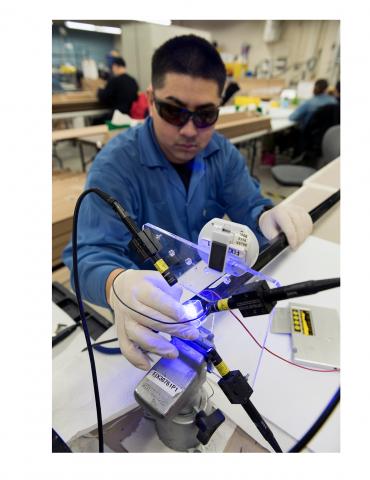
Anyone overseeing a production process involving UV curing understands the importance of monitoring and validating that the process is working within spec. Too great a deviation in the system performance can have disastrous consequences, from shortened life of the product, to total product failure. To assure the highest quality and minimize failures, many organizations incorporate routine measurement of the light output of their system
Before you begin comparing radiometer specifications, there are a few simple questions to answer that can help narrow down your selection. The first one is does your process require an ISO/IEC17025:2017 accredited calibration with NIST traceability? Accreditation is often required for products and components used in the medical, automotive and aerospace industries, among others. If it does, be sure to select only radiometers that specify that they come with an ISO/IEC 17025:2017 Accredited calibration certificate.
The second relates to the curing process itself. Curing processes such as belt, oven, chamber and some area applications require that the light meter itself be exposed to UV light (vs just a remote sensor). In this case you would need a meter that can withstand the intensity of the UV light, and in many cases the increase in temperature during UV exposure. This type of meter would require a UV resistent housing, such as aluminum. A meter with a plastic housing and exposed display would not be able to travel underneath UV lamps, or be put into a UV chamber, for example.
Once you have determined these factors, you can begin looking at the features and benefits of different UV light meters, and selecting one that best fits your application. There are a variety of UV curing light measurement systems on the market that were designed specifically to monitor the light output from UV sources used for curing. Consequently each manufacturer has unique designs that yield different results. Some were optimized for cost and may lack performance and quality. This may include linearity and traceable/repeatable calibration, for example. Some were designed for research/lab/product development with high price points, making them too expensive for end-user production environments. Most systems were designed based on customer feedback with specific curing applications and/or materials in mind.
There are many designs of both photoinitiators and light sources in use, making designing a measurement system to work universally across platforms challenging. Add to this the fact that there is no industry standard stating which wavelengths you should measure, or how the spectrum should be weighted, or at which wavelength the system should be calibrated. In short, light measurement system designs vary greatly by manufacturer, leaving many unanswered questions for end-users in selecting the right measurement system for their application.
So how do you select the best light meter for UV curing when the parameters can vary so greatly? In order to select the correct meter for your application, you need to understand what features of the meter are most important to ensuring a proper cure. Below are some of the terms used by light measurement system manufacturers, along with basic definitions.
A UV meter is also often referred to as a radiometer, optometer or light meter. It is a tool capable of measuring the absolute (calibrated) amount of light power within a certain portion of the electromagnetic spectrum, called wavelengths.
The wavelengths or spectrum of light are often expressed in nanometers (nm). In particular 200 - 450 nm is typically defined as the ultraviolet region, applicable for curing. We note here that 380 nm - 450 nm (blue/violet light) is visible to the human eye. Though considered visible light, for curing it is still often called UV.

Matching the UV spectrum with a radiometer is challenging because in this region there are a limited selection of sensor and filter materials with low absorption and stable physical properties that can withstand extended and large amounts of UV exposure. An ideal UV sensor would have flat/uniform response over the specific band that effects the cure, and would block all other wavelengths. However most UV sensors suffer from low and varying sensitivity over the UV range. Therefore assuring proper wavelength selection of a meter can be tricky in itself.
The first step is to determine which wavelengths the lamp/light source emits. Next, and possibly more important, is knowing which of these emitted wavelengths actually effect the cure.
The photoninitiators’ response to UV light is directly related to its absorption, and is very wavelength selective. For an effective cure the light source wavelength has to match the photoinitiators’ absorption peak, which can range from 200 to 450nm depending on the specific product and application. Short wavelengths are often selected for thinner surface applications, to allow faster throughput speeds. Longer wavelengths are absorbed into the substrate and offer greater depth penetration for thicker materials.
Like the photoinitiator, your UV sensor, will also have a fixed sensitivity response to the light. It is important to select a measurement system that matches both the spectral output of the UV source and the photoinitiators response to UV light. If you are curing a photoinitiator with a specification for UVA (315- 390 nm) it is easy to see the blue curve in Figure 1 will capture the UVA portion the best, and will ignore inputs from 200-315 nm as well as 400-450 nm, that are not important.
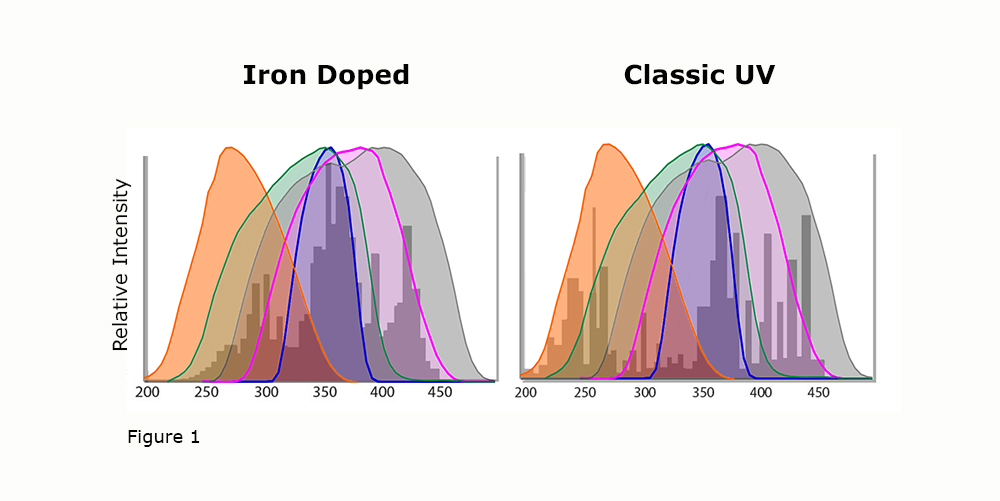
There are two main units of measurement for Curing: Irradiance expressed in W/cm2 (watts per square centimeter), and Dose or Exposure expressed in J/cm2 (joules per square centimeter square). It is important that the UV meter you select can handle both the minimum and maximum irradiance and dosage requirements.
Irradiance is the amount of light reaching a surface. It is sometimes referred to as the intensity of the UV. Higher UV intensity is often important for thicker substrates, to ensure the output is capable of penetrating deep enough to allow a complete cure. Longer wavelengths of UV are often measured when cure depth is important, as longer wavelengths are absorbed into coatings for deeper penetration.
The reading for irradiance is W/cm2. It can be expressed in standard format using prefixes such as micro (µ) or milli (m) or using scientific notation (1.2e-3). For example 1.2 mW/cm2 can also be expressed as .0012 W/cm2, 1.2e-3 W/cm2, or 1200 µW/cm2. See Figure 2 for clarification.
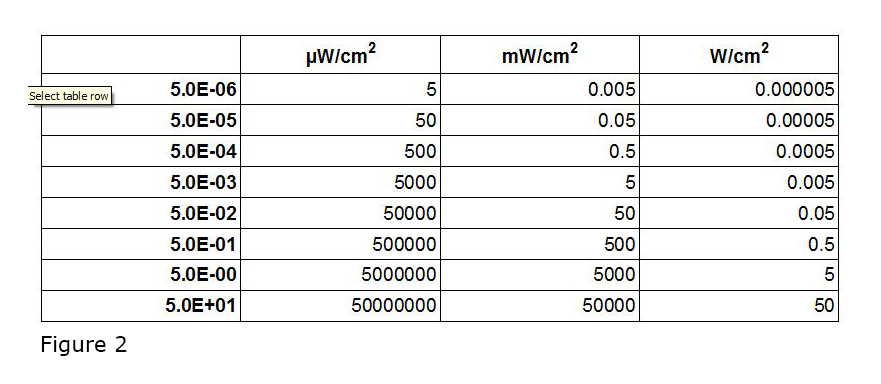
Dosage (also referred to as exposure) indicates the total amount of light reaching a surface over a period of time. The reading for dose is J/cm2. It can be expressed in standard format using prefixes such as micro (µ) or milli (m) or using scientific notation (1.2e-3). For example 1.2 mJ/cm2 can also be expressed as .0012 J/cm2, 1.2e-3 J/cm2, or 1200 µJ/cm2. Therefore Figure 2 can also be used to clarify the ranges by swapping the units from W/cm2 to J/cm2.
Dosage is the summation of irradiance over time, using the formula (W/cm2 x seconds). It is often referred to as the integrated irradiance. This total of the UV exposure during the curing cycle is a critical measurement for all lamp types, photoinitiators, and light meters. It allows for changes in intensity on conveyors as well as belt speeds, alignment, distance etc. It accounts for variations in the intensity during a measurement cycle, and over long periods of time. It simplifies measurements by allowing a single number to be used for verification that a process is supplying enough total radiation to complete the task. As the intensity of the lamp decreases with age, it is often possible to extend the life of the lamps by monitoring both the peak irradiance and total dosage, and increasing the length of exposure time during the process, thus saving on premature and costly lamp replacements.
The dynamic range, (or measurement range), of a UV meter is often expressed in W/cm2. For example if the noted range for your meter is 1 mW/cm2 to 20 W/cm2, the smallest dosage the meter can measure is 1 mJ/cm2 because (1 mW/cm2 x 5 seconds = 5 mJ/cm2). The maximum dosage figure is more complicated as it is dependent on how many seconds the meter can measure while integrating. For example if your meter can integrate for 30 seconds, and its max irradiance is 20 W/cm2, the max dose it can measure is 600 J/cm2.
The resolution of a UV meter is how many decimal places its readout can display. For a UV meter that has a minimum measurement of 5 mW/cm2, it is common that the display would show 2 digits of resolution (5.00 mW/cm2). When taking a measurement at the lowest range, it is important to understand that these digits of resolution would likely not be reflected as accurately, as they are below the minimum measurement value and could be effected by noise and linearity. However when the readings are higher, for example 5.12 W/cm2, the .12 should be accurate as they are above the 5 mW/cm2 (.005 W/cm2) minimum range.
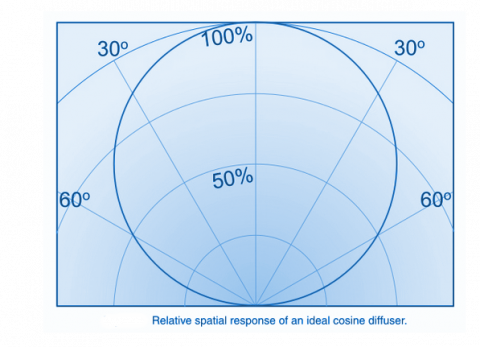
Spatial response (cosine response) is a common cause of deviation when comparing UV measurement systems. Input optics are used to improve the spatial
response of a measurement system. A perfect sensor would have a spatial response that matches cosine law. Input optics should be designed so that the light is diffused as much as possible to create a uniformly illuminated condition where the sensor receives an equal amount of light disregarding its location. A flat diffusive window can only create cosine correction within a limited angle, and its angular response drops very fast at large angles.
When reflectors or highly reflective surfaces are used to improve the amount of UV light reaching the product, it is very important that the system used to measure the light has very good cosine response. If it doesn’t, much of the reflected light will be omitted from the irradiance and dosage measurements. Integrating spheres can have nearly ideal cosine correction, however it is difficult to fit a bulky integrating sphere into the same measurement plane as the product being cured. When selecting a UV meter for applications using highly reflective surfaces, asking for confirmation of cosine response can be as important as choosing the right spectrum. ILT’s ILT800 CureRight Radiometer incorporates a mini integrating sphere into its optical chamber. This unique design bends the light path 90 degrees to fit into a thin tight space inside the radiometer, allowing for a near perfect cosine angular response.
A sensor that does not have cosine correction will have a narrower field of view. Reflected light is omitted from measurement (see the image on the left in Figure 3.) A cosine corrected sensor captures light based on cosine law to more accurately mimic the light received by a product under cure in the oven. See sample image on the right in Figure 3.
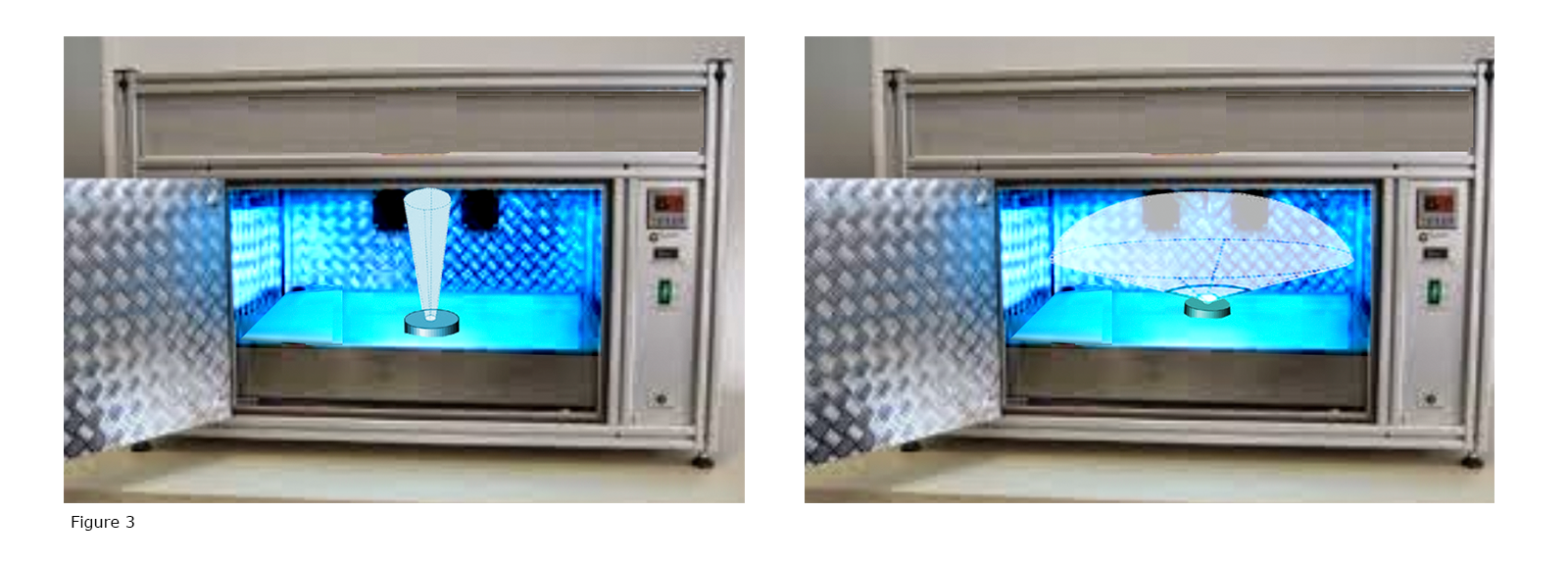
There are some other features to consider looking for in a UV meter. These may not be required in all cases, but should be considered when comparing cost and benefit:
Data storage and comparison: It is possible to write a procedure that states when the irradiance falls below a certain value, to increase the duration of exposure to achieve total specified dose. When the irradiance falls below a minimum threshold, maintenance is required. Having the ability to store readings can be very valuable for trouble shooting both the light source systems and the radiometer. It can also be helpful to be able to share data with your lamp and curable materials suppliers when problems arise.
Temperature monitoring. All sensors are prone to drift when heated. Monitoring the sensors’ temperature can be beneficial if you must use the system to test when already warm, or if there are frequent changes in temperature during the testing period. In some applications it can also be an indicator of product failure for substrates that should not be over heated.
Profiling. Profiling is a graphical representation of the irradiance over time. It is especially useful for troubleshooting multi-lamp systems as it enables problem detection of an individual lamp/reflector assembly by running a single test on all lamps simultaneously, but displaying the results of each lamp/reflector assembly separately. The alternative is testing each lamp individually, running the meter underneath each time. It provides a quick and easy way to visually see how stable the sources is are over time, determine the best warm up period, and complete troubleshooting tasks. Some systems not only store a baseline, but also allow data analysis. This may include comparing the saved base line to the current measurement as shown below. Some may require the data to be saved and exported to a spreadsheet to view the profile, or use a propietary interface. Some suppliers charge a premium to add profiling, while some include it at no cost.

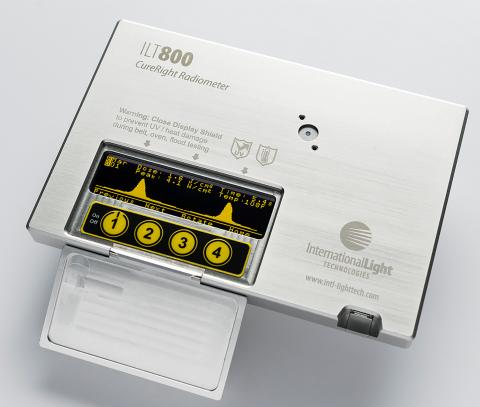
ILT’s new CureRight Radiometer Series includes data storage, temperature, and profiling all at no additional cost.
- Features large measurement range of 4.5 decades in 1 model, auto ranging
- mW/cm2 to 40 W/cm2
- Effortless results, clear data, easily identifies problem
- Profiling is standard
- 3000 samples per second
- Integration for up to 10 minutes
- Measure pulsed and continuous sources
- Store/Recall up to 1000 profiles
- Mapping: face horizontally, vertically, up or down
- Linear response- no range selection required
- Temperature measurement
- Low battery warning
- Made in USA
- ISO17025 accredited calibration
- Custom & OEM inquiries welcome
International Light Technologies has been developing and manufacturing light measurement systems for over fifty years. Our extensive portfolio of light meters meet a variety of UV light measurement applications, including UV curing. All of our light measurement systems can be tailored to meet a specific requirement or application. We maintain an ISO17025 accredited calibration lab, and all of our meters come with an ISO17025 calibration certificate.
Learn more about the ILT800 CureRight Radiometer.

